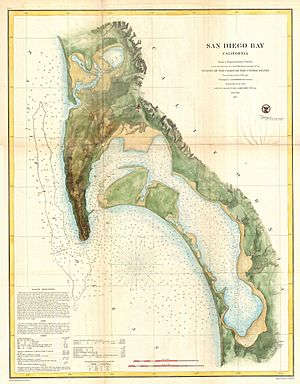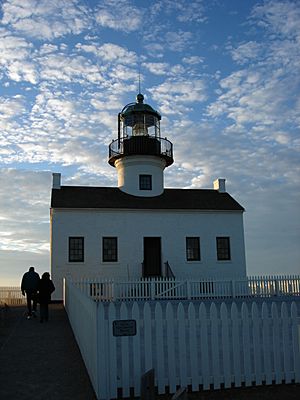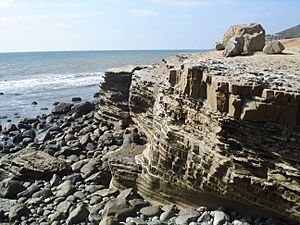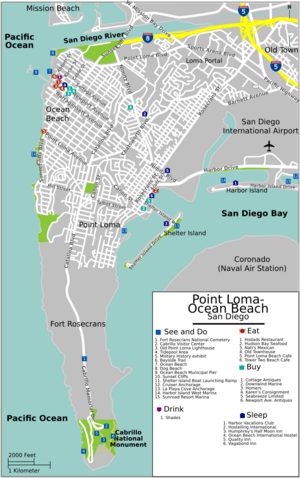Point Loma, San Diego facts for kids
Quick facts for kids
Point Loma
|
|
|---|---|
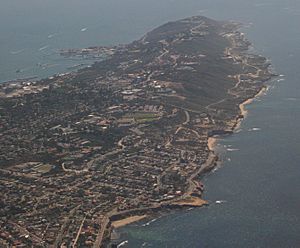
Aerial view of Point Loma, facing south, March 2007
|
|

The Point Loma peninsula at left
|
|
| Country | |
| State | |
| County | |
| City | |
| ZIP Code |
92106 and 92107
|
Point Loma is a beautiful seaside community in San Diego, California. It's a hilly piece of land, like a finger pointing into the ocean. The Pacific Ocean is on its west and south sides. San Diego Bay and Old Town are to the east. The San Diego River is to the north.
Point Loma and the Coronado peninsula together form San Diego Bay. They separate the bay from the big Pacific Ocean. The name "Point Loma" can mean both the neighborhood and the whole peninsula.
About 47,981 people live in Point Loma, including the Ocean Beach area. This number is from the 2010 Census. The main planning area for Point Loma covers about 4,400 acres (1,780 hectares).
Point Loma is very important in history. It's where the first Europeans landed in what is now California. Today, Point Loma has two big military bases, a national cemetery, a national monument, and a university. It also has many homes and businesses.
Contents
History of Point Loma
The name "Loma" comes from the Spanish word for "hill." The original Spanish name for the area was "La Punta de la Loma de San Diego." This means "Hill Point of San Diego." Later, it was shortened to Point Loma. The native Kumeyaay people called it 'Amat Kunyily,' which means "black earth."
Native people did not live permanently on Point Loma. This was because there was not enough fresh water. However, Kumeyaay people likely had a seasonal village there. They also visited Ocean Beach to gather seafood like mussels and lobsters.
European Discovery
Europeans first found Point Loma on September 28, 1542. A Portuguese explorer named Juan Rodríguez Cabrillo led an expedition. He sailed from Mexico for the Spanish king. His goal was to explore the west coast of what is now the United States.
Cabrillo described San Diego Bay as "a very good enclosed port." Historians think he landed his ship on Point Loma's east shore. This was probably at a place called Ballast Point. This landing was the first time Europeans came ashore in California. Because of this, Point Loma is often called "where California began."
It took more than 200 years for Europeans to build a lasting settlement in San Diego. This happened in 1769. The Mission San Diego was in the San Diego River valley. But its port was a beach in Point Loma called La Playa. "La Playa" means "the beach" in Spanish.
The historic La Playa Trail was the oldest European trail on the West Coast. It connected the Mission to La Playa. Ships would anchor at La Playa and unload their goods using small boats. Part of this trail is now Rosecrans Street.
In the 1830s, sailors camped at La Playa. They collected cattle hides to export. They also hunted for wood and rabbits in the Point Loma hills. La Playa remained San Diego's main port until the 1870s. That's when New Town (today's downtown) was built.
Ballast Point got its name because ships would drop their heavy ballast there when they arrived. They would pick up new ballast when they left for the ocean. A fort called Fort Guijarros was built at Ballast Point in 1797. Today, Ballast Point and La Playa are part of Naval Base Point Loma.
Military History
San Diego's long connection with the U.S. military started in Point Loma. The southern part of the peninsula was set aside for military use in 1852. Over the years, the Army built coastal defenses there. They named the area Fort Rosecrans.
The U.S. Navy began to have a big presence in San Diego in 1901. This was when the Navy Coaling Station was built in Point Loma. The Marine Corps Recruit Depot San Diego opened in 1921. The Naval Training Center San Diego opened in 1923. Both were in Point Loma. The Naval Training Center closed in 1997.
During World War II, the entire southern part of the peninsula was closed to civilians. It was used for military purposes. After the war, the area kept many Navy commands. These included a submarine base and an electronics lab. They were later combined into Naval Base Point Loma. Other parts of Fort Rosecrans became Fort Rosecrans National Cemetery and Cabrillo National Monument.
Lomaland and Aviation
After its founder died in 1891, the Theosophical Society moved its main center to "Lomaland." This was a hilltop campus in Point Loma with ocean views. The campus had unique buildings and ways of living. It became a center for music and culture in San Diego from 1900 to 1920.
The Society grew most of its own food. They also experimented with planting trees and crops like eucalyptus and avocado. This is why that part of Point Loma is now heavily wooded. Today, the Lomaland site is the campus of Point Loma Nazarene University.
In the 1920s, there was a dirt airstrip called Dutch Flats. It was in the Midway neighborhood of Point Loma. This is where Charles Lindbergh first tested and flew his famous airplane, The Spirit of St. Louis. The plane was built in San Diego by the Ryan Aeronautical Company. A U.S. Post Office now stands on the site. It has plaques remembering Dutch Flats and Lindbergh.
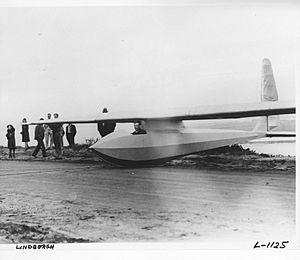
Point Loma was also a popular spot for gliding from 1929 to 1935. This was because of the sea breezes and its long ridge. William Hawley Bowlus, who helped build the Spirit of St. Louis, lived in Point Loma. He built the first American sailplane, the Bowlus SP-1. He flew it along the west side of Point Loma, setting new American endurance records.
Bowlus and his students set soaring records there. One student, Jack C. Barstow, soared over Point Loma for over 15 hours in 1930. This was an unofficial world record at the time. Because of these achievements, Point Loma was named a National Landmark of Soaring in 1996. A plaque is near the launching area at the Cabrillo National Monument.
Important Landmarks
The most famous landmark in Point Loma is the Old Point Loma lighthouse. This lighthouse is sometimes used as a symbol for San Diego. It was finished in 1854 and first lit on November 15, 1855. It sits high up, about 422 feet (129 meters) above sea level.
However, this high location turned out to be a bad choice. Fog and clouds often hid the light from ships. So, on March 23, 1891, the lighthouse stopped being used. A new lighthouse was built closer to the water.
The Old Point Loma Lighthouse is now open to the public. Its inside has been restored to look like it did in the 1880s. It is part of the Cabrillo National Monument. This monument is named after Juan Rodríguez Cabrillo, the first European to see San Diego Bay. The lighthouse is listed on the National Register of Historic Places.
Besides the lighthouse, five other sites in Point Loma are on the National Register of Historic Places:
- Cabrillo National Monument
- Fort Rosecrans National Cemetery
- The Marine Corps Recruit Depot Historic District
- Naval Training Center San Diego
- Rosecroft
Point Loma is also a National Landmark of Soaring. This is because of the many record-breaking glider flights that happened there. Two plaques honoring these flights are near the entrance to the Cabrillo National Monument.
Geography of Point Loma
How Point Loma Was Formed
On the west side of Point Loma, there are sandstone cliffs along the ocean. These are called the Sunset Cliffs. Geologists call these cliffs the Point Loma Formation. They hold fossils, including dinosaur fossils, from about 75 million years ago. This makes it one of the few places in California with dinosaur fossils.
Above the Point Loma Formation is another layer of rock called the Cabrillo Formation. This layer is also from the Late Cretaceous period. It can be seen in different parts of Point Loma.
The top of the peninsula is mostly flat. It reaches about 422 feet (129 meters) high. This flat top is covered by younger sandstone and gravel from the Pleistocene era. This was about 1 million years ago or less. These flat layers sit directly on top of the older Point Loma and Cabrillo formations. There is a gap in the rock record of about 70 million years. This means no new rock was laid down, or old rock was worn away.
The cliffs on the ocean side are steep. They are always being worn away by ocean waves. On the east side, the land slopes more gently towards San Diego Bay. Homes and buildings are built right up to the water's edge there. At the northern end of the peninsula, the cliffs get lower. They disappear completely in Ocean Beach and the Midway area. This is where the San Diego River flows.
Much of the Midway area used to be marshland. It was filled in to build on. The San Diego River used to flow through Midway into San Diego Bay. This made Point Loma an island. To prevent San Diego Bay from filling with silt, the river was moved. A levee built in 1877 changed its path to north of Point Loma.
Some parts of Liberty Station and Point Loma Village are also built on filled land. This land was reclaimed from sand and wetlands around the Bay. The only remaining wetland in Point Loma is Famosa Slough. It is a nature preserve owned by the city. It branches off the river near its mouth.
Point Loma Neighborhoods
Point Loma has several different neighborhoods. Most of them have mainly single-family homes. The main shopping and business area is called Point Loma Village. Its shops serve local people, as well as those interested in yachting and fishing. Hundreds of jacaranda trees line the streets in Point Loma Village. These were planted to make the area more beautiful.
The newest business area is Liberty Station. This used to be the Naval Training Center San Diego. Now it has homes, offices, shops, and schools. The Midway district is at the northern end of the peninsula. It is next to the San Diego River and the I-5 and I-8 freeways. Midway is mostly for businesses and industry, with a few small housing areas.
Shelter Island is connected to Point Loma Village by a road. It's not a true island. It was a sandbank in San Diego Bay. It was built up into dry land in the 1950s using material dug from the bay. The Port of San Diego controls it. Shelter Island has hotels, restaurants, marinas, and public parks.
The bayside neighborhood called La Playa is a bit north of the original La Playa beach. That beach was where ships anchored long ago. La Playa has some of the most expensive homes in San Diego. Some homes by the bay have private docks for small boats.
The hills above La Playa are known as the Wooded Area. This is on the bay side of Catalina Boulevard. It's called "Wooded Area" because of its many old trees. The ocean side of these hills is called the College Area. This is because Point Loma Nazarene College is nearby. The Sunset Cliffs neighborhood is on the west side. It sits on top of ocean bluffs and is famous for its Pacific Ocean views.
Roseville is named after San Diego pioneer Louis Rose. It is the oldest settled part of the peninsula. Roseville was once a separate town. Many Portuguese fishermen and boat owners settled there over 100 years ago. Some people call the area "Tunaville" because of its connection to the tuna fishing fleet. The hilly area above Roseville is called Fleetridge. It is named after its developer, David Fleet.
The bayside hills between Rosecrans Street and Chatsworth Boulevard are known as Loma Portal. A unique thing about this neighborhood is that some street lights are in the middle of intersections. Loma Portal is directly under the flight path for planes taking off from Lindbergh Field. This means conversations often stop when a plane flies overhead. This is sometimes called the "Point Loma Pause." The east-west streets in Roseville and Loma Portal are named after authors in alphabetical order.
The northwest corner of the peninsula is Ocean Beach. This is where the San Diego River meets the ocean. The southern one-third of Point Loma is all federal land. This includes Naval Base Point Loma, Fort Rosecrans National Cemetery, and Cabrillo National Monument.
Wildlife in Point Loma
Point Loma has many kinds of wildlife. You can find them in the federal lands at the south end of the peninsula. These areas are partly managed as a nature reserve. You can also see wildlife in the neighborhoods.
Animals you might see include raccoons, skunks, possums, bats, rabbits, California ground squirrels, gray foxes, and sometimes coyotes. More than 300 types of birds have been seen in Point Loma. This area is on the Pacific Flyway, a route for migrating birds.
Economy of Point Loma
Point Loma's economy relies on a few main things. These include military bases, local shops, and ocean recreation. This means things like yachting and deep-sea fishing.
Tourism and Recreation
Most ocean activities happen on the Bay (east) side of the peninsula. There are three yacht clubs here. One is the San Diego Yacht Club, which hosted the America's Cup sailing race from 1988 to 1995. Point Loma also has several small boat marinas on the Bay side.
There is a commercial dock for sport fishing trips. You can also go on seasonal whale watching tours from here. Point Loma has the largest sport fishing fleet in Southern California. Many businesses related to boating and fishing are on the Bay side. These include marine supply stores, yacht brokers, boat repair shops, and hotels for fishing fans. Some restaurants and hotels even have docks for customers who arrive by boat.

Tourists and locals visit the cliffs on the western side of the peninsula. They go there to see the ocean and the sunset. That's why they are called Sunset Cliffs. The cliffs can be dangerous because they are unstable. People have been injured or even died from falling there.
Point Loma has many hotels, restaurants, and local businesses. The Point Loma Youth Hostel is in the Voltaire business district, near Ocean Beach. Travelers from all over the world stay there. The San Diego Sports Arena and the SOMA concert venue are in the Midway neighborhood of Point Loma.
Military Presence
Point Loma is home to several large military bases. These include the US Navy's SPAWAR program. It also has the US Marine Corps' Recruit Training Depot (MCRD San Diego). And there is Naval Base Point Loma. The Navy controls about 1,800 acres (728 hectares) of Point Loma. It provides jobs for about 48,000 military and civilian people.
Naval Base Point Loma is at the southern end of Rosecrans Street. It is home to Submarine Squadron 11, which has several nuclear submarines. It also houses the Naval Mine and Anti-Submarine Warfare Command. This includes eight mine countermeasures ships. The naval base also has large electronic and communications operations. These serve the Pacific Fleet.
At the southern tip of the peninsula is historic Fort Rosecrans. This was where the U.S. Army's Coast Artillery Corps was during World War I and World War II. Fort Rosecrans also includes the Fort Rosecrans National Cemetery and the USS Bennington Monument.
The Naval Training Center San Diego was a basic training facility for new Navy recruits for over 70 years. It also had many special schools for advanced training. In April 1997, the base closed. The schools moved to Illinois. The old base is now Liberty Station. This is a 361-acre (1.46 km²) project. It has homes, offices, shops, schools, and arts areas. Liberty Station also has a 9-hole golf course and a 46-acre (18.6 hectare) waterfront park. A 100-acre (0.4 km²) historic district there is listed on the National Register of Historic Places.
Culture and Events
Annual Events
The Day at the Docks festival happens every April. It celebrates Point Loma's sport fishing industry.
The Festa do Espirito Santo, or Feast of the Holy Spirit, is a religious festival. Point Loma's large Portuguese community puts it on. It has happened every year since 1910. It is San Diego's oldest ethnic tradition.
The Cabrillo Festival is held every October. It is a weekend-long event. It remembers the landing of Juan Rodriguez Cabrillo in Point Loma in 1542.
From June through September, famous musicians and comedians perform. They play at an outdoor concert venue on Shelter Island.
A free outdoor concert series features local musicians. These concerts happen on five Friday evenings in a local park each summer.
Since 1952, the St. Nicholas Home Tour has been held. It happens on the first Saturday in December. The tour usually shows 4 to 6 beautiful homes decorated for the holidays. It also includes tea, cookies, and caroling. This is said to be the oldest home tour west of the Mississippi River.
Point Loma is known for its Christmas decorations. Several blocks of Garrison Street are especially famous for their elaborate displays. There is also a neighborhood-wide lighting of luminarias on Christmas Eve. This happens in the Plumosa Park area. On two Sundays in December, there is a Parade of Lights. Boats decorated with bright lights sail on the Bay. People can watch them from the shoreline.
Arts and Entertainment
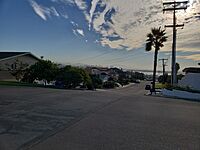
Parts of the Top Gun movies were filmed at the New Point Loma Lighthouse. The sequel, Top Gun: Maverick, was filmed at Fort Rosecrans National Cemetery. A shipyard set for The Hunt for Red October (1990) was filmed at Naval Base Point Loma.
Werner Herzog filmed scenes for My Son, My Son, What Have Ye Done (2009) on the streets of Point Loma. Ken Davitian filmed scenes for The Samuel Project (2018) at Shelter Island Cleaners. Alexandra Slade filmed a scene for Friend of the World (2020) at Sunset Cliffs. Scenes from Antwone Fisher (2002) and Skid Marks (2007) were also filmed in Point Loma.
Community Groups
Point Loma has several community groups. The Point Loma Association is a non-profit group. It works to make the area more beautiful and improve the community. There is also the Peninsula Chamber of Commerce. Service clubs like Rotary, Kiwanis, Optimists, and Lions are also active.
Parks and Libraries
Point Loma has a few small neighborhood parks. It also has the Cabrillo Recreation Center. There is a large waterfront park at Liberty Station. This park also has a nine-hole golf course. Most of the oceanfront along the peninsula is a public park. It is called Sunset Cliffs Natural Park. The Point Loma Native Plant Garden has plants and flowers that grow naturally in the San Diego area. Cabrillo National Monument is a federal historic park at the southern end of the peninsula.
The James Edgar and Jean Jessop Hervey Public Library opened in 2003. It replaced a much smaller library. The new library was partly paid for by a donation from the Hervey family. They had strong ties to the area. Jean Jessop Hervey used to visit the old Point Loma Library every Tuesday to read with her children.
The library is over 25,000 square feet (2,322 square meters) and holds over 80,000 books. It has a kitchen area, a community meeting room, and outdoor patios. The lower floor is the largest children's library in San Diego. It has a pretend ship, reading desks shaped like surfboards, an art space, and a Story Time Zone. The library's design has a nautical theme to connect with Point Loma's location. There is even a working periscope from a U.S. Navy submarine. Visitors can use it to see the neighborhood around them. The floor in the entry lobby has a map of the Point Loma Peninsula made of terrazzo. The library also holds events like story time for children, after-school movies, and arts and crafts.
Education in Point Loma
Point Loma has many schools. These include public, charter, and private schools. They serve elementary, middle, and high school students. There are also private preschools, an adult school, and a university.
Point Loma's public schools are part of the San Diego Unified School District. Neighborhood public schools include Point Loma High School, two middle schools, and seven elementary schools. There is also a public charter school campus at Liberty Station. This campus has three high schools, two middle schools, and one elementary school. They are all part of High Tech High. Point Loma also has a K-12 religious school, a religious elementary/middle school, and a private elementary/middle school.
Higher education is offered at Point Loma Nazarene University. This is a Christian liberal arts college. Its campus has ocean views and used to be the home of the Theosophical Society. The peninsula also has a branch campus of the San Diego Community College District.
Point Loma Infrastructure
The Interstate 8 freeway runs along the northern edge of the Point Loma peninsula. It follows the San Diego River and ends near the Pacific Ocean. Rosecrans Street is the main north-south road on the bay side of Point Loma. Sunset Cliffs Boulevard is the main north-south road on the ocean side. These two streets run parallel to each other and to Catalina Boulevard, which is on top of the hill.
Other major roads in Point Loma include Sports Arena Boulevard, West Point Loma Boulevard, Harbor Drive, and Nimitz Boulevard.
Most streets in the coastal areas are in a grid pattern. The blocks on the ocean side are larger than those on the bay side. The grid pattern breaks down in the hilly center of Point Loma. Here, streets follow the curves of the land. Some streets are broken into separate sections by canyons or hills. Because of the hills, canyons, and the narrow shape of the peninsula, traffic often has to take long, winding routes.
Notable People from Point Loma
- Charlotte Johnson Baker, 1855–1937, San Diego's first woman doctor.
- Fred Baker (physician), 1854–1938, a doctor and community leader.
- Belle Benchley, 1882–1973, director of the San Diego Zoo for 25 years.
- Dennis Conner, 1942–, a famous yacht racer.
- Richard Henry Dana Jr., 1815–1882, author who wrote about early San Diego.
- Kevin Faulconer, 1967–, former Mayor of San Diego.
- Reuben H. Fleet, 1887–1975, founder of Convair (an aircraft company).
- Randy Gardner, 1947–, holds a record for the longest time without sleep.
- Jack O. Gross, 1905–1985, founder of KFMB-TV.
- Ed Harris, 1946–, a member of the San Diego City Council.
- Frankie Laine, 1913–2007, a famous singer.
- Daniël de Lange, 1841–1918, a Dutch composer.
- Bob Mendoza, a professional baseball player and coach.
- Maureen O'Connor, 1946–, San Diego's first female Mayor.
- Robert O. Peterson, 1916–1994, founder of Jack in the Box fast food chain.
- Conrad Prebys, 1933–2016, a developer and generous giver to charity.
- Alfred D. Robinson, 1866-1942 and Marion James Robinson, 1873–1919, built Rosecroft.
- Louis Rose, 1807–1888, an early developer and founder of Roseville.
- T. Claude Ryan, 1898–1982, an aviation pioneer and founder of Ryan Aeronautical.
- Albert Spalding, 1850–1915, founder of the A. G. Spalding sports equipment company.
- Katherine Tingley, 1847–1929, a Theosophist and founder of Lomaland.
- Judith M. Tyberg, 1902–1980, a yogi, Sanskrit scholar, and founder of the East-West Cultural Center.
- Joseph Wambaugh, 1937–, a well-known author.
|
See also
 In Spanish: Point Loma para niños
In Spanish: Point Loma para niños



